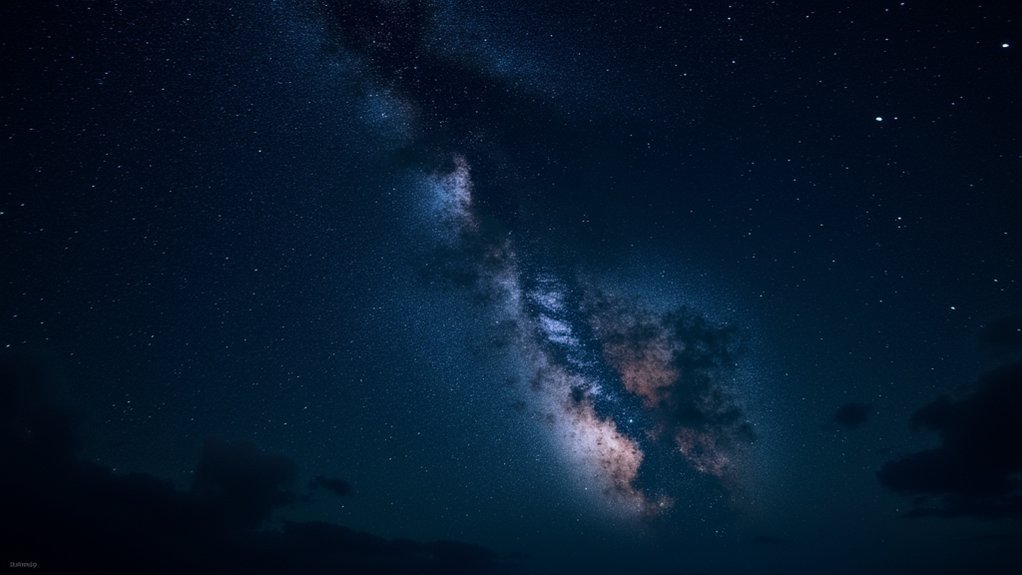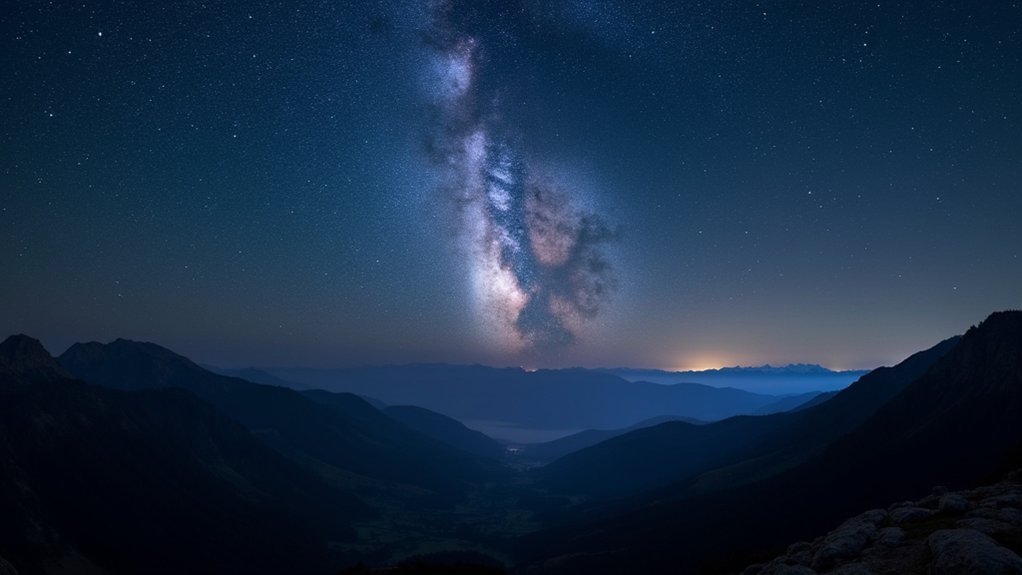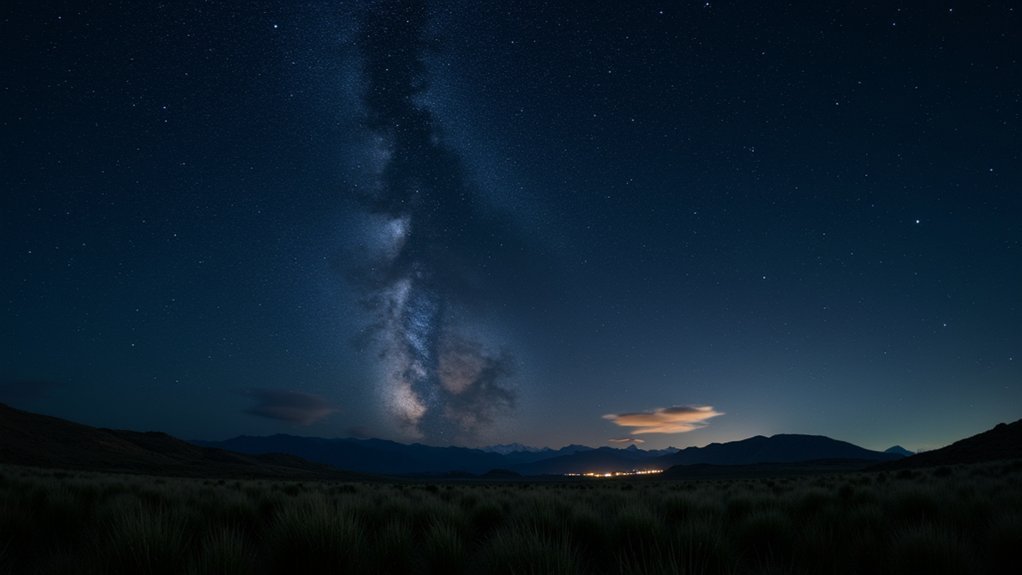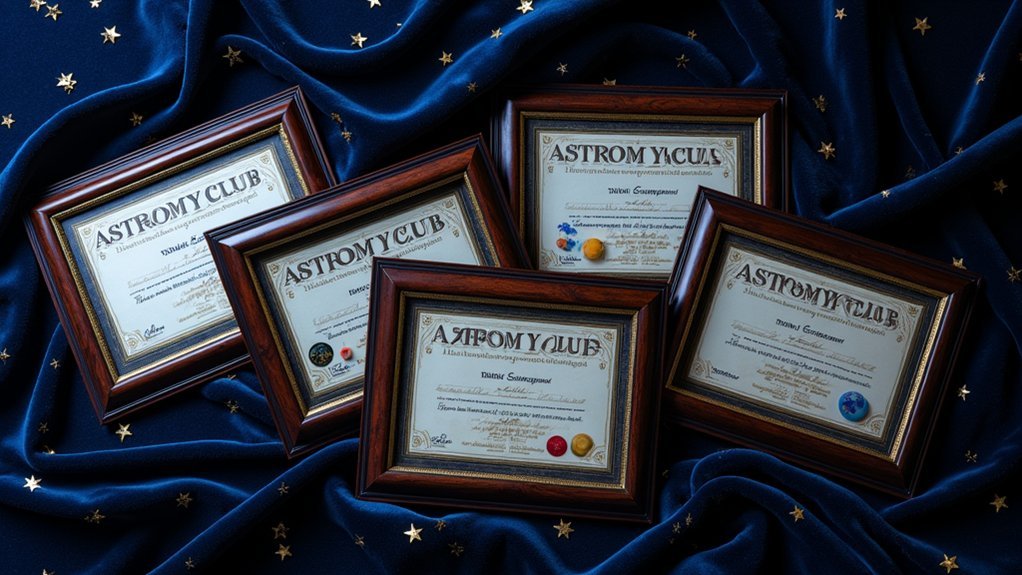New moon nights offer the absolute best stargazing conditions as they eliminate lunar light interference. Tonight’s moon phase determines your viewing potential—the closer to new moon, the more stars you’ll see. For ideal results, seek locations with minimal light pollution and clear weather. Faint objects like galaxies and nebulae become visible only during these dark periods. Binoculars or a telescope will greatly enhance what celestial wonders await your discovery in the moonless sky.
Why New Moon Periods Offer Superior Stargazing Conditions

When the moon vanishes from our night sky, a universe of stellar opportunities emerges. During new moon phases, you’ll experience considerably reduced light pollution, creating favorable conditions for observing faint celestial objects that typically remain hidden.
Mark your calendar for April 27, 2025—this new moon provides perfect stargazing conditions throughout the night. Without moonlight interference, you’ll enjoy enhanced visibility of deep-sky objects, revealing galaxies and nebulae with stunning clarity. The Milky Way’s delicate structure becomes dramatically more apparent during these dark periods.
New moons also maximize meteor shower experiences, particularly the Lyrid meteor shower peaking April 21-22. The absence of lunar light guarantees you’ll catch even the faintest meteors streaking across the sky, transforming an ordinary night into an extraordinary astronomical adventure.
Monthly Calendar of Moon-Free Nights for Optimal Viewing
Planning your stargazing adventures around moon phases can dramatically improve your celestial observations. April 2025 offers several exceptional moon-free nights for ideal viewing of celestial objects.
| Date (April 2025) | Stargazing Conditions |
|---|---|
| 21-22 | Lyrid meteor shower peak; minimal impact from waning crescent moon |
| 24-25 | Early-setting waxing crescent moon provides dark evening skies |
| 27 | New moon (third of five supermoons in 2025); complete darkness |
| 29 | Excellent morning viewing with Venus and Saturn visible before sunrise |
| Late April | Clear night skies following the new moon offer premier visibility |
For the absolute best stargazing experience, prioritize April 27’s new moon night when moonlight won’t interfere with your view. The nights immediately before and after also provide exceptional conditions for observing faint celestial details.
Dark Sky Locations to Maximize Your Moonless Night Experience

To maximize your moonless night experience, seek out rural parks that have earned official Dark Sky designations where light pollution is virtually non-existent.
Check light pollution maps online before planning your trip, as even a one-hour drive from the city can dramatically improve your view of celestial objects.
Higher elevation locations will reward you with clearer, more vibrant stars by reducing atmospheric interference that can blur or dim your view of the night sky.
Rural Parks Offer Best
Rural parks serve as celestial sanctuaries for stargazers seeking pristine night skies without the interference of moonlight. When you visit these locations during moon-free nights, you’ll experience considerably darker skies than in urban areas, making faint celestial phenomena suddenly visible.
National and state parks typically provide ideal stargazing conditions with well-maintained facilities, open fields, and elevated viewpoints. These areas shield you from light pollution that washes out the night sky in cities.
For optimal observation, time your visit during a new moon phase when even the dimmest stars shine brightly. Many rural parks host regular astronomy events where enthusiasts gather to share the experience.
Before planning your trip, check with local astronomy clubs—they can recommend the best rural parks and upcoming moon-free nights for your stargazing adventure.
Light Pollution Ratings Matter
When searching for the perfect stargazing spot on a moonless night, light pollution ratings serve as your most valuable navigational tool.
These ratings help you identify locations where artificial light won’t interfere with your view of celestial objects during moon-free nights.
For ideal stargazing experiences, consider these light pollution factors:
- Dark Sky Parks provide officially designated areas with minimal light interference, perfect for observing deep-sky objects.
- Light pollution maps highlight rural areas away from urban centers where stars shine brightest.
- Bortle scale ratings of 1-3 indicate excellent visibility conditions for meteor showers and faint stars.
- Elevation advantages often correlate with lower light pollution, as higher locations sit above light domes.
The darker your chosen location, the more celestial wonders you’ll discover on moonless nights.
Elevation Improves Visibility
While finding a location far from city lights greatly enhances stargazing, ascending to higher elevations dramatically improves your celestial viewing experience during moonless nights.
At higher altitudes, you’ll encounter less atmospheric interference, allowing for clearer visibility of stars and distant celestial objects.
Combine elevation with dark sky locations for ideal results. When you venture to elevated areas like mountain observatories or high plateaus on moon-free nights, you’re effectively bypassing layers of air pollution that typically obscure stellar details.
The atmosphere thins as you ascend, reducing light scatter that normally diminishes stargazing quality.
Plan your observing sessions during the hours after sunset or before dawn when the sky is naturally darker.
These periods, combined with higher elevation and the absence of moonlight, create perfect conditions for spotting the best stars.
Weather Patterns That Enhance Visibility During Moonless Nights

High pressure systems create ideal stargazing conditions on moonless nights by delivering clear, stable air that minimizes atmospheric turbulence.
You’ll experience better “seeing” (the term astronomers use for atmospheric stability) when humidity levels remain low, allowing starlight to reach your eyes with minimal distortion.
These weather patterns often persist for several days, giving you multiple opportunities to observe celestial objects with exceptional clarity and detail.
High Pressure Systems
Clear, pristine skies await stargazers who plan their observations during high pressure systems on moonless nights.
These weather patterns create ideal conditions for viewing the cosmos, especially during the new moon phase when darkness is most complete.
When high pressure dominates, you’ll benefit from:
- Enhanced stability – Reduced atmospheric turbulence provides sharper views of stars and constellations
- Minimal cloud cover – Clear skies offer unobstructed visibility of even faint celestial objects
- Lower humidity – Decreased atmospheric haze improves overall clarity and detail
- Reduced light pollution impact – The combination of high pressure conditions and no moonlight minimizes the glow from urban areas
These favorable atmospheric conditions maximize your stargazing potential, revealing deep-sky objects that remain hidden during less favorable viewing periods.
Humidity’s Seeing Impact
Humidity plays a profound role in determining your stargazing experience during moonless nights. When humidity drops below 60%, you’ll notice dramatically improved visibility of celestial objects. The dry air minimizes atmospheric distortion, allowing stars to appear brighter and sharper without the Moon’s interfering light.
Look for high-pressure weather patterns that bring stable, dry air masses—these create ideal conditions for clear skies. You’ll find exceptional stargazing opportunities following a cold front, when humidity levels naturally decrease and atmospheric disturbance settles.
Nighttime temperature inversions often coincide with lower humidity, giving you pristine views of the night sky.
For your best chance at spectacular star-watching, monitor local forecasts and plan your observation sessions when humidity is low. These dry conditions transform moonless nights into perfect windows for exploring the cosmos.
Celestial Objects Best Observed Without Moonlight Interference
When the moon disappears from the night sky, a universe of dim celestial wonders becomes visible to the naked eye.
During the new moon phase, particularly April 27, 2025, you’ll experience ideal dark skies for stargazing without moonlight interference. The absence of lunar brightness reveals celestial objects that typically remain hidden.
Four celestial targets that shine best during moon-free nights:
- Faint nebulae – Delicate gas clouds like the Orion Nebula show intricate details only visible in true darkness.
- Distant galaxies – Andromeda and other galaxies appear clearer without lunar glare.
- Star clusters – The Pleiades and other clusters reveal their fainter members.
- Meteor showers – The Lyrids (peaking April 21-22) display more meteors when viewed during waxing crescent or new moon periods.
Essential Equipment for Moonless Night Stargazing Sessions
To fully experience the wonders of moonless nights, you’ll need proper equipment that enhances rather than hinders your stargazing experience.
Quality binoculars offer improved visibility of fainter stars that moonlight typically obscures, while a telescope with large aperture reveals detailed views of distant galaxies and nebulae during these dark conditions.
Don’t forget a star chart or stargazing app to help identify constellations and plan your celestial observations for ideal visibility.
Preserve your night vision with red LED flashlights when maneuvering or adjusting your equipment—white light will reset your eyes’ dark adaptation.
Finally, prepare for comfort during extended viewing sessions with warm clothing and a comfortable blanket or chair.
Moonless nights provide the best conditions for observing celestial objects, so proper preparation will maximize your experience.
Frequently Asked Questions
What Moon Phase Is Best for Stars?
The new moon phase is best for stargazing as you’ll experience the darkest skies without moonlight interference. You’ll also get good viewing during waxing crescent phases when the moon sets early.
What Time Is the Best Time to See the Stars Tonight?
You’ll see the best stars tonight between 8 PM and midnight after sunset when the sky is fully dark. If there’s moonlight, try observing before moonrise or after moonset for clearer views.
What Moon Shines Tonight?
Tonight, you’ll see a waning crescent moon, illuminated at just 10%. It’s providing minimal light, which is perfect for your stargazing. You’ll enjoy clearer views of stars and constellations with this dim lunar presence.
What Time of Night Is Best to See Stars?
You’ll enjoy the best star viewing 1-2 hours after sunset when complete darkness sets in, and again around midnight when constellations reach their highest point. Choose clear, moonless nights for ideal visibility.
In Summary
You’ll discover moonless nights transform your stargazing experience dramatically. Plan your observations during new moon phases to reveal faint galaxies, nebulae, and star clusters typically washed out by moonlight. Don’t forget to check weather forecasts and seek dark sky locations for ideal viewing. With the right equipment and timing, you’re set to witness the universe’s true brilliance that only reveals itself when the moon doesn’t compete for attention.





Leave a Reply